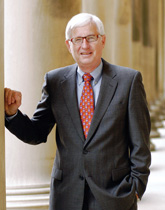
Half a dozen people crammed into the small room to witness a revolution. Eyes fixed on the computer screen, Fred Gilman and other members of the Stanford Linear Accelerator Center watched the online data analysis. These particle physics pioneers understood that the data plots meant something dramatic. "You could literally see, at certain points, discoveries being made," Gilman says. It was 1967, and they were witnessing "a huge breakthrough ... that the zoo of particles was made out of something called quarks."
That discovery further changed our understanding of particles, such as protons and neutrons.
Gilman stayed at Stanford for 23 more years to continue researching the breakthrough before beginning what he calls his "second career."
He left academia to become head of the Physics Research Division at the Department of Energy's Superconducting Super Collider project in Texas, which was building the world's premier particle accelerator. When funding was cut a few years later, Gilman decided "not just to go back [to Stanford]" and leapt into his "third career" by joining the physics department at Carnegie Mellon in 1995.
Beginning last April, he began his "fourth career" as dean of the Mellon College of Science. From that vantage point, he is witnessing another revolution in the world of physics. "Ninety-five percent of the universe is not the matter we all know; it's something else," Gilman says. This dark matter, he explains, clumps to form the underpinning for the cosmic web; we can observe its gravitational pull, but we know little else. He recently oversaw the opening of the Bruce and Astrid McWilliams Center for Cosmology, which will explore the mysterious dark matter.
Discoveries for Gilman won't end there, though. His latest career will also keep him focused on breakthroughs in biology, chemistry, and math.
—MELISSA SILMORE (TPR'85)



